| Type | Two seat experimental |
| Engine | 1 Argus As 10C |
| Dimensions | Length 11.15 m, span 15.40 m with 10 ° angle, height 3.66 m, wingarea 32.86 m2, aspect ratio 7.22 |
| Weights | Empty 925 kg, fuel 100 kg, oil 10 kg, load (including pilot) 525 kg, flying weight 1450 kg, wingloading 44.12 kg/m2 |
| Performance | Max. speed 180 km/h at sea level, cruising speed at sea level 160 km/h, climb 2.70 m/s, service ceiling 4000 m, range 320 km, endurance 2 h |
| Type | Werk.Nr | Registration | History |
| D-2360 | Built by Focke-Wulf in 1933 |

